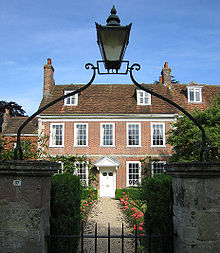- Sash window
-
A sash window or hung sash window is made of one or more movable panels or "sashes" that form a frame to hold panes of glass, which are often separated from other panes (or "lights") by narrow muntins.[1] Although any window with this style of glazing is technically "a sash", the term is used almost exclusively to refer to windows where the glazed panels are opened by sliding vertically, or horizontally in a style known as a "Yorkshire light", sliding sash or sash and case (so called because the weights are concealed in a box case). The design of the sash window is attributed to the English scientist and inventor, Robert Hooke.[2] The oldest surviving examples of sash windows were installed in England in the 1670s, for example at Ham House.[3]
The sash window is often found in Georgian and Victorian houses, and the classic arrangement has three panes across by two up on each of two sashes, giving a "six over six" panel window, although this is by no means a fixed rule. Innumerable late Victorian and Edwardian suburban houses were built in England using standard sash window units approximately 4 feet (1.2m) in width, but older, hand-made units could be of any size, as the image illustrates. It consists of an upper and lower sash that slide vertically in separate grooves in the side jambs or in full-width metal weatherstripping. This type of window provides a maximum face opening for ventilation of one-half the total window area. Each sash is provided with springs, balances, or compression weatherstripping to hold it in place in any location.[4]
To facilitate operation, the weight of the glazed panel is usually balanced by a heavy steel, lead, or cast iron sash weight or counter-weight concealed within the window frame. The sash weight is connected to the window by a sash cord or chain that runs over a pulley at the top of the frame, although spring balances are sometimes used. Sash windows may be fitted with simplex hinges, which allow the window to be locked into hinges on one side while the counterbalance on the other site is detached, allowing the window to be opened for escape or cleaning.
The name "hung sash window" is more usual in the United States, and typically refers to a double hung window with two sashes that can move up and down in the window frame. A single hung window has two sashes but normally the top sash is fixed and only the bottom sash slides. Triple and quadruple hung windows are used for tall openings, common in New England churches.
Construction is usually of softwood, and units are generally single glazed; although double-glazed sashes are available it is more common for single-glazed sash windows to be replaced with top-hung casements when double glazing is retro-fitted. Some top-hung double-glazed units are manufactured to give the appearance of sashes.
Traditional problems with wooden sash windows include rot, swelling or distortion of the woodwork, rattling in the wind (due to shrinkage of the wood), and problems brought on by careless application of paint. The sliding mechanism makes sash windows more vulnerable to these problems than traditional casement windows. Sash windows are relatively high maintenance, but offer advantages in return (looks, abides by laws (relating to older houses and buildings), natural resources etc). It is also possible to clean all the glass from within the building by sliding the two panes to different positions.
In recent years, uPVC sash windows have become available. These aim to replicate the aesthetic qualities of traditional sash windows, while overcoming many of the shortcomings - especially regular maintenance and painting, and energy inefficiency.
A significant advantage of sash windows is that they provide efficient cooling of interiors during warm weather. Opening both the top and bottom of a sash window by equal amounts allows warm air at the top of the room to escape, thus drawing relatively cool air from outside into the room through the bottom opening.
See also
- Witch window
- Fortochka
References
- ^ Ching, Francis (1997). A Visual Dictionary of Architecture. New York: Van Nostrand Reinhold. ISBN 0-442-02462-2.
- ^ Louw, HJ, Architectural History, Vol. 26, 1983 (1983), pp. 49-72+144-150 JSTOR, BBC
- ^ "The Gardens of Ham House". London Gardens Trust. http://www.londongardenstrust.org/features/ham.htm.
- ^ http://www.oldhouseweb.com/how-to-advice/double-hung-window-construction.shtml
External links
Categories:- Windows
Wikimedia Foundation. 2010.


